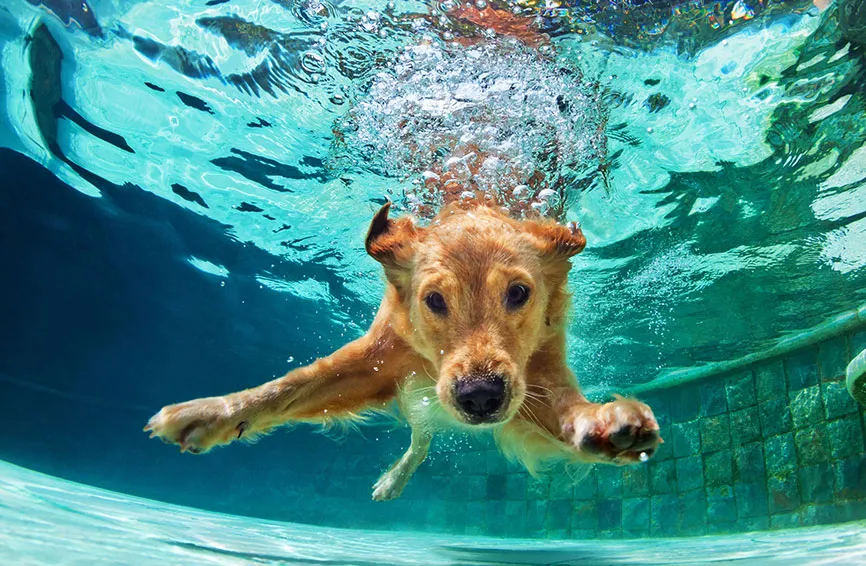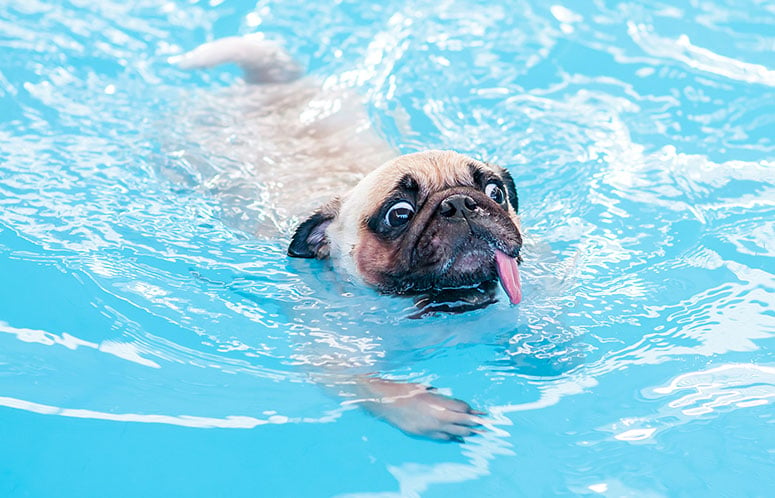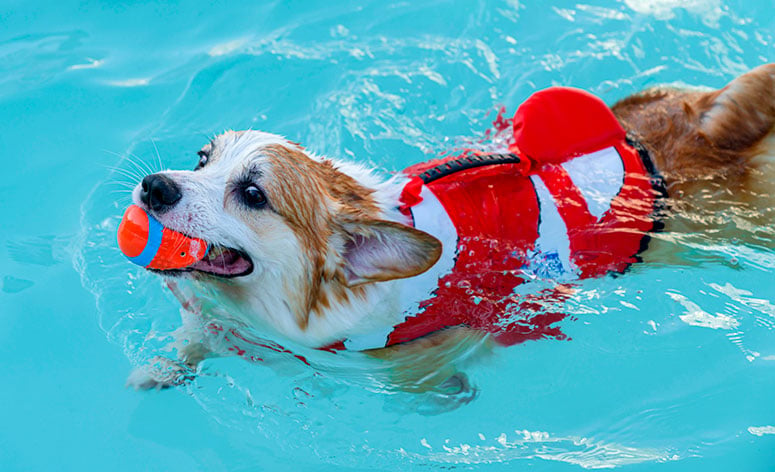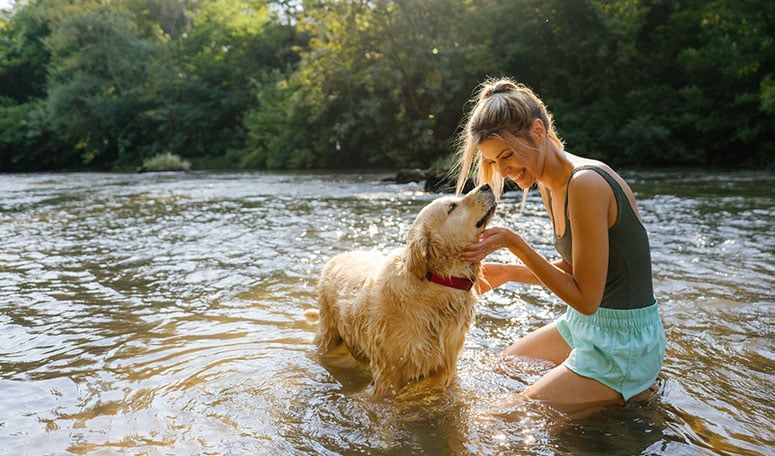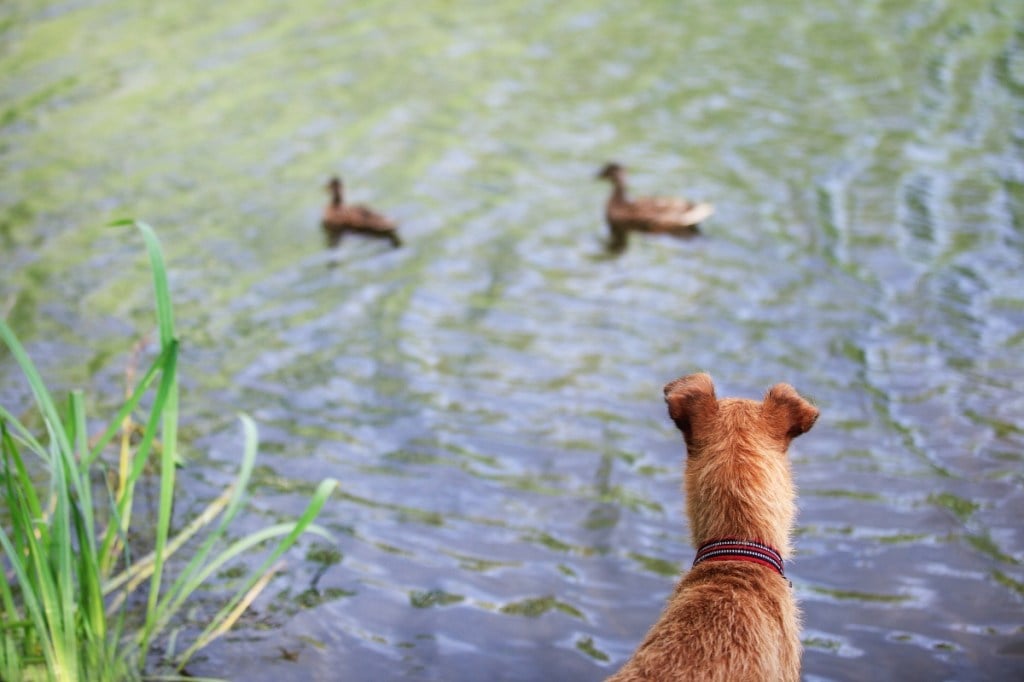Key Takeaways
- If your puppy or dog is fearful or dislikes water, you can teach them to swim, provided they don’t have physical limitations.
- The key is to go slowly and work up to full immersion with positive reinforcement.
- For most dogs, swimming is a recommended way to exercise, play and cool off. A shallow pool provides a respite from the heat for those who can’t swim.
Table of Contents
Is there anything more joyful than seeing a dog leap into the water after a toy and then come back ashore, shaking his body and wagging his tail?
Swimming is an excellent activity for most dogs for mental stimulation and exercise. For dogs with joint issues or injuries, it may be the only way they can exert themselves. It’s also a top-notch way for a dog to regain strength and assist in the healing process after an injury. And on a hot day, swimming is the quickest way to cool your dog down.
However, a love of water and swimming does not come naturally for all dogs. Some breeds are known to love water – Labrador retrievers, Newfoundlands, and Portuguese water dogs – to name a few.
Other breeds, especially brachycephalic or flat-faced breeds such as pugs, English bulldogs and boxers, may not like water, and swimming could be dangerous for them because of their difficulty breathing. Some breeds also have physical characteristics that make swimming challenging, such as basset hounds with short legs, heavy heads, and long floppy ears. These dogs can still enjoy the water; just make sure it’s shallow and you supervise them.
Those general rules of thumb don’t always apply. I had a black Lab who would only go in shallow water to cool off; he had no interest in swimming.
It’s possible to train a dog to enjoy the water. My current dog, a rescue from Mexico who appears to have some Labrador in him, was fearful of water when I first adopted him. As the weather warmed up, he became comfortable with putting his feet in, then slowly more of his body. I took him paddleboarding, which he loved immediately. Then I started tossing a toy in the water – at first close by and gradually further. Now he loves the water so much that he runs to it and waits for me to throw something.
If your pet is not a breed with limitations, teaching your dog to swim can be a fun and rewarding experience and improve your bond with your furry friend. It is essential to introduce them to the water gradually, and make sure they feel comfortable and safe.
Do not try to teach young puppies how to swim. You’ll want to wait until they are at least two to five months old.
If you are not sure you can do the training yourself, you could contact a local dog trainer and see if it’s something they can help with.
Here are some tips on how to teach your dog to swim:
Choose the right location: Select calm and shallow water for your dog’s first swimming lesson. A pool or a lake with a gradual slope is ideal for beginners. Ensure the area is safe and free from hazards, such as strong currents or sharp rocks. The water should be cool but not frigid, and outside temperatures should be at least in the 50s F. A kiddy pool is a great way to introduce your puppy to water. Begin with a small amount of water and put some favorite toys in the pool.
Use a life vest or flotation device: Just like humans, dogs need a life vest to keep them afloat while learning to swim. A life vest will also give your dog a sense of security and make them feel more comfortable in the water. Select a dog life jacket made of ripstop material with a handle to grab them easily. For some dogs, wearing clothing, including a life vest, can cause anxiety. So, it’s essential to set them up for success by not introducing them to multiple new things on the same day. First, help your dog feel comfortable wearing the life vest by putting it on them every day, starting with five minutes and gradually increasing the time, before taking them to swim. Even after your dog becomes a confident swimmer, a life jacket is helpful if the water is deeper than paws can touch. Rivers and oceans can have unpredictable currents, or your pet could become entangled in seaweed or debris.
Introduce your dog to the water gradually: Let them wade in up to their ankles, then slowly encourage them to venture deeper. Dogs will naturally feel more comfortable if they can touch the ground with their feet, as they adjust to the sensation of being in water. Use positive reinforcement, such as treats and praise, to reward your dog for their progress. Don’t ever push or throw them in the water against their will – that will only make them more afraid and damage their trust in you.
Show your dog how to swim: If your dog hesitates, you can show them by getting in the water with them, assuming you know how to swim. If your dog is scared, hold them to keep them afloat. Once they seem comfortable in the water, swim around in front of your dog and encourage them to follow you. This is easier if one person is holding your dog, while the other is gently coaxing them to swim. You can also use a toy or a ball to entice your dog to swim. When throwing a toy or ball, don’t throw it more than a couple feet at first, and gradually increase the throwing distance, until your dog is confident swimming.
Stay close and monitor your dog: It is essential to always stay close to your dog while they are in the water. Keep an eye on their body language and behavior and be ready to help them if they need it. If your dog becomes tired and starts panting, take a break, and try again another day. It’s important not to push your dog’s physical limits to the point that they are struggling to swim or panting excessively, as this could cause trauma. Also, when you have multiple dogs in the home and are introducing a new dog to swimming, remember they may overexert themselves trying to keep up with the other dogs. A dog who is a confident swimmer can provide a great example and encouragement for a beginner, as they demonstrate.
Rinse your dog off after swimming: After your dog’s swim, rinse them off with fresh water to remove any chlorine or salt from their coat. This will help prevent skin irritation and keep their coat looking healthy.
Teaching your dog to swim takes patience, persistence, and positive reinforcement. With the right approach and a little practice, your dog can become a confident and happy swimmer, ready to enjoy the water with you.
For dogs that don’t want to be around water, here are other ways to keep them cool.
Be aware of toxic algae
Before you allow your dog into any natural body of water, be sure it is free of blue-green algae. With climate change, this toxic substance is turning up in more places and numerous pet parents have lost their dogs because of it.
Simply swimming in a body of water with blue-green algae puts the person or pet at serious risk of becoming fatally ill. Dogs are more susceptible to poisoning because they are more likely to drink the water or lick their wet fur after swimming.
Toxic algae produces a neurotoxin that can cause liver damage, lead to respiratory paralysis and quickly become fatal. Initial symptoms may include vomiting, diarrhea, and seizures, weakness, difficulty breathing, disorientation, and collapse.
You’ll want to avoid this fate, so here are some things to look for:
- Look for signs or notices that local health authorities may have posted.
- It may look like grains of floating green sand or scum or pea soup.
- An appearance of paint or paint chips on the surface of the water
- Water smells bad
- Algae can also lurk under the water’s surface or attach to plants, making it harder to detect
Before you head out, look for information and updates on nearby lakes and ponds by checking your local news outlets, county websites and park departments.
